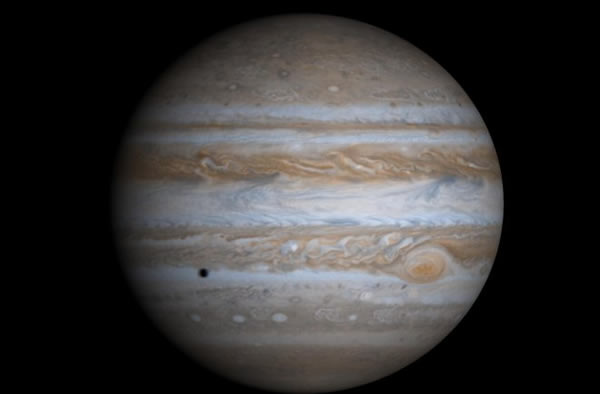Jupiter: How to Observe the Solar System's Giant
NASA's Cassini mission to Saturn flew past Jupiter in 2000, capturing the shadow of Europa in the gas giant's atmosphere.
Over the last few weeks, sky watchers have been treated to some truly spectacular views of the moon silently drifting past the mighty planet Jupiter.
The sad thing is that many people noticed "that bright star near the moon" but only a few recognized it as the largest planet in the solar system. On learning the true nature of this "star" many were surprised that it was so bright and easy to see with the naked eye.
Jupiter holds many more surprises for those with a telescope, but you don't even need any specialized astronomical equipment to reveal its secrets -- even a bird watching telescope will produce better views than what Galileo could attain over 400 years ago.
With a little practice, try keeping an eye on the Jovian moons -- they move quite fast and even over a period of just an hour or two it's possible to see their positions drift. During very special occasions you can spot the moons pass directly in front of the planet and see their shadow fall on the gas giant. You may even see them disappear behind the planet.
The secret to getting a good view of Jupiter is to use a magnification of at least 50x. That puts detailed views of the planet out of reach of most binoculars, but a good pair of 7x50's can at least reveal the four larger Galilean moons: Io, Europa, Ganymede and Callisto. Higher magnifications of 50x and beyond will reveal detail in the top of the planet's atmosphere such as the cloud belts and the famous Great Red Spot.
Jupiter is a gas giant made from different chemicals that slowly change to liquid toward the core. Anyone looking for the first time will notice bands running across the disk; the darker ones known as 'belts' where material is descending, the lighter ones are 'zones' where ammonia clouds are brought up to the top of the atmosphere and the dark lines between the two are known as 'bands.'
High velocity winds known as jet streams form the belts and blow in opposite directions between the belts and zones. One of the most famous of Jupiter's features is the Great Red Spot which is a hurricane larger than Earth and can be found in the Southern Equatorial Belt.
The appearance of these features through a telescope can be quite subtle, but it is possible to enhance them with the use of color filters attached to the eyepiece. The filters screw in to the 'telescope' end of the eyepiece before its placed into the eyepiece holder and come in a range of colors. Different colours will enhance different details but, in my experience, a light blue filter such as the Lumicon #82A brings out the contrast and enhances the general view of the planet nicely.
Jupiter really does have something for everyone, whether you are watching it slowly march across the sky night after night and slowly change brightness, or trying to chase its moons with binoculars. Maybe you are a telescope owner studying the atmosphere in fine detail, but however you decide to study the planet it won't ever let you down. There are always some Jovian surprises in store.
Jan 31, 2013 09:45 PM ET by Mark Thompson












